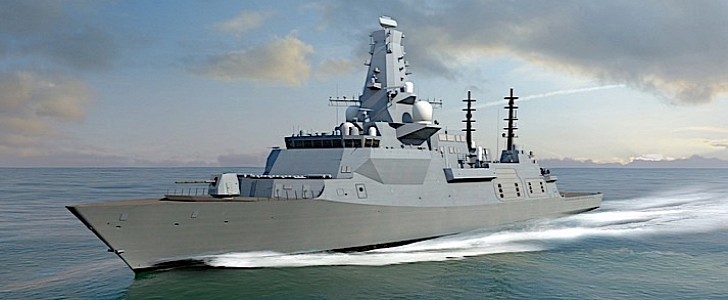Just like its American counterpart, the Royal Navy is hard at work trying to modernize its fleet. One of the ways it will do this is the so-called City Class Type 26 frigate now being built in the shipyards of BAE Systems.
Type 26 is a class of ships meant to replace the Type 23 frigates that have been in service since 1987. They are meant as anti-submarine warships to be used by the Royal Navy’s Continuous At Sea Deterrent and Carrier Strike Group.
Until this week, two of them were under construction. The HMS Glasgow, which has been already rolled out of the build hall for its two halves to be joined, and the HMS Cardiff, which is about 40 percent ready.
This week, a third Type 26 ship entered production. It’s called HMS Belfast, and its build was kicked off by His Royal Highness, Prince William, Duke of Cambridge, setting the plasma cutting machine on the first steel that will go into the ship.
According to BAE Systems, the steel plate “will form part of a unit which will contain the machinery space for the gearbox and stabilizers of HMS Belfast.”
The Type 26 ships will be packed with weapons, ranging from the Sea Ceptor missile defense system to a 5-inch medium caliber gun. They will also come with a flexible mission bay, Artisan 997 Medium Range Radar, and towed array sonar. On their deck, Chinook-sized helicopters could easily land.
BAE says these vessels will be among the most eco-friendly out there. They come with hydrodynamically designed hulls to optimize fuel efficiency and anti-fouling coating to prevent marine growth on the hull.
Emissions abatement for the diesel engines will be employed to help reduce nitrogen oxide exhaust emissions, and a wastewater treatment system will be used to make sure nothing truly nasty reaches the water when effluent is discharged.
Until this week, two of them were under construction. The HMS Glasgow, which has been already rolled out of the build hall for its two halves to be joined, and the HMS Cardiff, which is about 40 percent ready.
This week, a third Type 26 ship entered production. It’s called HMS Belfast, and its build was kicked off by His Royal Highness, Prince William, Duke of Cambridge, setting the plasma cutting machine on the first steel that will go into the ship.
According to BAE Systems, the steel plate “will form part of a unit which will contain the machinery space for the gearbox and stabilizers of HMS Belfast.”
The Type 26 ships will be packed with weapons, ranging from the Sea Ceptor missile defense system to a 5-inch medium caliber gun. They will also come with a flexible mission bay, Artisan 997 Medium Range Radar, and towed array sonar. On their deck, Chinook-sized helicopters could easily land.
BAE says these vessels will be among the most eco-friendly out there. They come with hydrodynamically designed hulls to optimize fuel efficiency and anti-fouling coating to prevent marine growth on the hull.
Emissions abatement for the diesel engines will be employed to help reduce nitrogen oxide exhaust emissions, and a wastewater treatment system will be used to make sure nothing truly nasty reaches the water when effluent is discharged.









